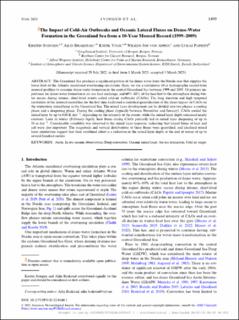| dc.contributor.author | Svingen, Kristin | |
| dc.contributor.author | Brakstad, Ailin | |
| dc.contributor.author | Våge, Kjetil | |
| dc.contributor.author | Von Appen, Wilken-Jon | |
| dc.contributor.author | Papritz, Lukas | |
| dc.date.accessioned | 2023-08-15T08:36:00Z | |
| dc.date.available | 2023-08-15T08:36:00Z | |
| dc.date.created | 2023-07-13T11:35:12Z | |
| dc.date.issued | 2023 | |
| dc.identifier.issn | 0022-3670 | |
| dc.identifier.uri | https://hdl.handle.net/11250/3084031 | |
| dc.description.abstract | The Greenland Sea produces a significant portion of the dense water from the Nordic seas that supplies the lower limb of the Atlantic meridional overturning circulation. Here, we use a continuous 10-yr hydrographic record from moored profilers to examine dense-water formation in the central Greenland Sea between 1999 and 2009. Of primary importance for dense-water formation is air–sea heat exchange, and 60%–80% of the heat lost to the atmosphere during winter occurs during intense, short-lived events called cold-air outbreaks (CAOs). The long duration and high temporal resolution of the moored record has for the first time facilitated a statistical quantification of the direct impact of CAOs on the wintertime mixed layer in the Greenland Sea. The mixed layer development can be divided into two phases: a cooling phase and a deepening phase. During the cooling phase (typically between November and January), CAOs cooled the mixed layer by up to 0.08 K day−1, depending on the intensity of the events, while the mixed layer depth remained nearly constant. Later in winter (February–April), heat fluxes during CAOs primarily led to mixed layer deepening of up to 38 m day−1. Considerable variability was observed in the mixed layer response, indicating that lateral fluxes of heat and salt were also important. The magnitude and vertical distributions of these fluxes were quantified, and idealized mixed layer simulations suggest that their combined effect is a reduction in the mixed layer depth at the end of winter of up to several hundred meters. | en_US |
| dc.language.iso | eng | en_US |
| dc.publisher | AMS | en_US |
| dc.title | The Impact of Cold-Air Outbreaks and Oceanic Lateral Fluxes on Dense-Water Formation in the Greenland Sea from a 10-Year Moored Record (1999–2009) | en_US |
| dc.type | Journal article | en_US |
| dc.type | Peer reviewed | en_US |
| dc.description.version | publishedVersion | en_US |
| dc.rights.holder | Copyright 2023 American Meteorological Society | en_US |
| cristin.ispublished | true | |
| cristin.fulltext | original | |
| cristin.qualitycode | 2 | |
| dc.identifier.doi | 10.1175/JPO-D-22-0160.1 | |
| dc.identifier.cristin | 2162224 | |
| dc.source.journal | Journal of Physical Oceanography | en_US |
| dc.source.pagenumber | 1499-1517 | en_US |
| dc.identifier.citation | Journal of Physical Oceanography. 2023, 53 (6), 1499-1517. | en_US |
| dc.source.volume | 53 | en_US |
| dc.source.issue | 6 | en_US |
